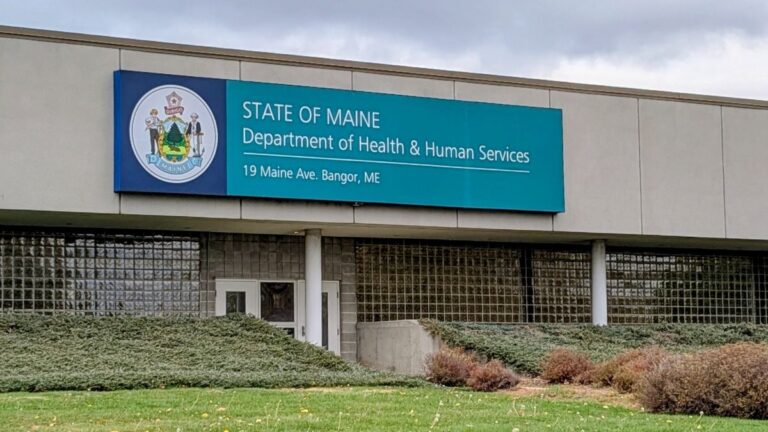Johnnie Walker, director of housing and shelter services at Partners for Peace, has worked at the domestic violence resource center for 25 years. When she started working there, the organization’s shelter, which serves Penobscot and Piscataquis counties, was emergency housing in the truest sense of the word.
“People were in and out of our shelter, in safe, affordable, permanent housing, in less than 30 days,” Walker recalled.
In recent years, Walker has seen shelter stay lengths increase dramatically. Now, she said, it’s common for survivors to stay between six months and a year.
Shelters are a vital resource for survivors of domestic violence, but there are not nearly enough beds statewide to meet demand. Maine has 162 beds in 11 domestic violence shelters across the state, according to a survey published in January by the Maine State Housing Authority.
In fiscal year 2024, shelters around the state were able to house just 14 percent of those who were eligible and looking for a bed, according to the Maine Coalition to End Domestic Violence.
Admittance rates at some regional resource centers were even lower. Partners for Peace told The Monitor they were able to admit only around 6 percent of those seeking a space; Safe Voices, which covers Oxford, Franklin and Androscoggin counties, reported similar figures. Through These Doors, in Cumberland County, was able to provide beds for just 40 of the 358 people who sought shelter with them last year, a roughly 11 percent admittance rate.
While a lack of beds has long been a problem, it has gotten worse in recent years, said staff at several resource centers, as people struggling to find more permanent housing in Maine’s hot housing market stay longer in shelters.
A shortage of housing units, the rising cost of rent and constraints on federal low-income housing assistance programs, particularly Section 8 Housing Choice Vouchers, are compounding the issue. If beds don’t open up, those waiting for a space may have to stay longer in unsafe situations.
Grace Kendall, director of development and engagement at Safe Voices, recalled a time when survivors stayed for an average of three or four months before they moved on to other housing. Now, Kendall said the average stay is nearly double that, closer to eight months.
Krissy Beaton, a residential services coordinator at the Hope and Justice Project in Aroostook county, reported an average stay length of six months — up from the previous average of six weeks. Several other resource centers said it is no longer uncommon for survivors to stay in emergency shelters for six months or longer.
The difficulty of finding housing often leaves survivors feeling trapped, said Francine Garland Stark, the executive director of the Maine Coalition to End Domestic Violence.
“The risk of being homeless or being in a shelter for months, maybe even a year, feels like a hopeless alternative to the terrible place that they are.”
Resource centers work with those they turn away to find alternate solutions.
“Sometimes, people call for shelter, and really what they need is a security deposit, or first month’s rent, or a bus ticket to get to a family or friend that has a safe place to stay,” said Walker, of Partners for Peace. Advocates may also make referrals to other domestic violence or homeless shelters.
For those who don’t want to leave their homes, advocates turn to safety planning.
“Safety planning is the foundation of advocacy work, because it’s really about helping folks navigate how to stay as safe as possible in their current reality,” said Kendall, of Safe Voices, which may mean setting up safety cameras or identifying people a survivor can call if their abuser shows up at their house.
Tight housing market, voucher freeze leave survivors with few options
Longer shelter stay lengths are a symptom of Maine’s housing crisis. Maine’s housing shortage was decades in the making, driven largely by the construction of too few homes. During the pandemic, the state experienced a population boom, with more than 20,000 people moving in between 2020 and 2022.
The spike in demand exacerbated the housing shortage. From 2020 to 2024, the state’s median home price grew by more than 50 percent. Workers’ wages, however, grew by less than 33 percent. A 2025 report from the National Low Income Housing Coalition found that a person earning minimum wage would need to work 61 hours per week to afford a one bedroom market rate rental in Maine.
During the pandemic, Maine also saw calls to domestic violence hotlines become more frequent — and more dire. According to a 2020 annual report from the Maine Coalition to End Domestic Violence, the number of phone calls to domestic violence helplines increased 24 percent from 2019 to 2020. Advocates were also spending more time on the phone with survivors, an indication that the need for assistance was greater, as The Monitor previously reported.
“Everyone expected the numbers to go up during COVID-19, because people were stuck at home,” said Kendall, of Safe Voices. “They were in very close proximity with their abusers.”
Advocates, however, did not expect the number of cases to remain elevated after quarantine had lifted — and to continue increasing, said Kendall.
“Our numbers go up every year, but the housing market can’t respond that quickly.”
Rising rents have meant that housing vouchers issued through federal rental assistance programs — which several resource centers said they once relied on to move survivors out of shelters — have not gone as far as they once did. The vouchers, which subsidize between 60 and 70 percent of the cost of rent for those who qualify, are paid for by the federal government and managed by housing authorities around the state.
The average cost per unit the vouchers were covering began rising sharply in 2018, according to federal data, and climbed to a high of $992 by the end of May, nearly double what it was a decade ago. It can take years on Maine’s centralized Section 8 waiting list to get a voucher, according to the South Portland Housing Authority.
The state’s housing authorities have exceeded their budgetary authority — meaning that they issued more vouchers than they had the funding to pay for — in four of the past six years, according to the U.S. Department of Housing and Urban Development. By the end of May, housing authorities statewide had already spent 97 percent of $147.9 million allocated to Maine this year.
When a housing authority goes over budget, the federal government asks it to stop issuing new vouchers. That was what happened in 2024, when several of Maine’s largest housing authorities — including Portland, Westbrook and MaineHousing, which oversees towns without a local housing authority — hit pause on issuing vouchers until enough new ones had been returned to circulation.
The pause was detrimental to domestic violence resource centers. In fiscal year 2024, New Hope Midcoast helped 15 families obtain a housing voucher. This fiscal year, they have only been able to place one family, who were on the centralized waiting list prior to the pause on new vouchers.
According to Scott Thistle, communications director for MaineHousing, the state housing authority resumed issuing new vouchers in April 2025, though they are not issuing as many as before the pause. MaineHousing issues one-third of the Section 8 vouchers in Maine. The remainder are issued by local housing authorities.
Several other resource centers said they are no longer able to place survivors into affordable housing through the voucher program, and instead rely on other assistance programs to move them out of the shelter.
The lengthy waitlist for vouchers, full shelters and the tight housing market have created a difficult situation for many people looking to flee an abusive relationship.
“Many survivors correctly decide that it is, in fact, safer for them to stay in an abusive relationship, because otherwise they would be living on the street,” said Kendall.
“We are seeing a lot more women, especially, who are staying in unsafe situations — because where are they going to go?”







